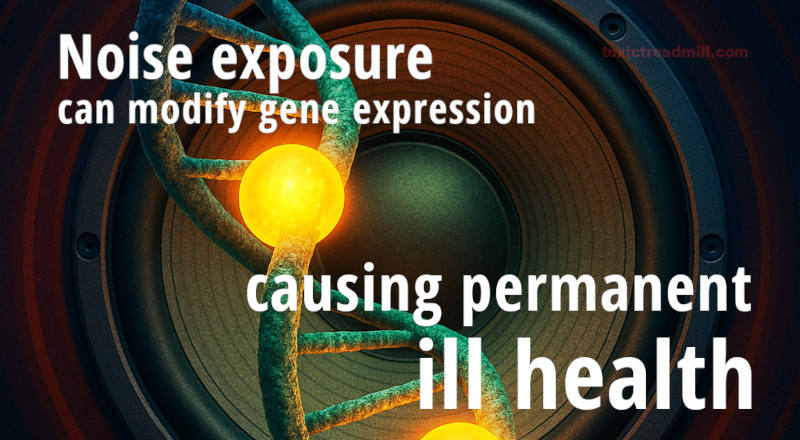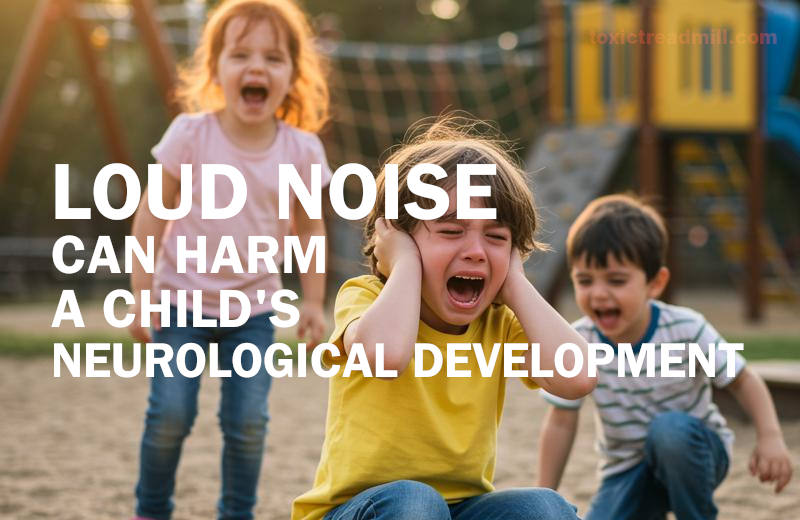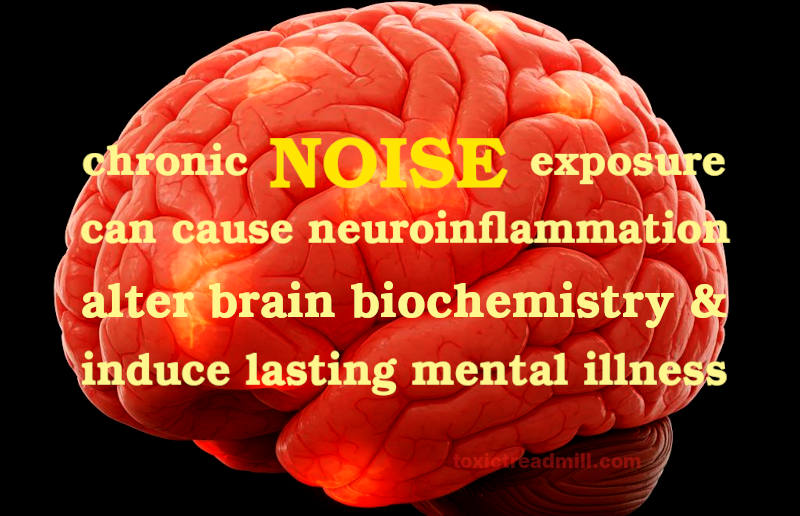Toxic Treadmill
Evidence for a Poisoned Planet
The Physical Toxicity & Harms of Unwanted Noise
Introduction
Noise pollution is an omnipresent environmental hazard that has been extensively associated with both physical and mental adverse health outcomes. Chronic and repeated exposure to unwanted or excessively loud sounds has emerged as an important risk factor for a spectrum of pathophysiological conditions, ranging from hearing impairment to endothelial dysfunction and mental health disorders. In recent decades, scientific investigations have demonstrated that noise, much like chemical toxicants, exerts deleterious effects via complex neurohormonal and biochemical pathways that ultimately disrupt human homeostasis.
We cannot choose not to hear noise. Taking measures to reduce its impact with protective equipment requires notice; sudden, unexpected noise cannot be avoided. Neither is it realistic to expect people to have to wear protective equipment in their own homes on a permanent basis. To reflect reality, noise needs to be viewed like a noxious gas. Deliberately abusive loud noise, including loud music, shouting, and repeated verbal assaults, need to be dealt with as seriously as a physical assault capable of causing permanent disability or death.

Mechanisms of Sound Transduction
At the most basic level, the process begins when sound waves enter the external auditory canal and strike the tympanic membrane, causing it to vibrate. These vibrations are transmitted via the ossicular chain (malleus, incus, and stapes) to the oval window, which in turn initiates pressure waves in the cochlear fluids. Within the cochlea, mechanical energy is converted into electrical signals through the stimulation of hair cells; these highly specialized sensory cells, which are arranged along the basilar membrane, transduce the mechanical vibrations into graded receptor potentials that are then converted into nerve impulses by ribbon synapses. This electrical signal travels along the auditory nerve, ultimately reaching the brainstem and higher auditory centres where it is interpreted as sound, a cascade that is critical for both communication and environmental awareness.
Noise-Induced Biochemical Responses
When sound exceeds normal auditory levels, particularly in the context of chronic and repeated exposures, the auditory system can no longer maintain its protective mechanisms. Excessive sound levels, such as those reaching 100 dB(A) or above, instigate both mechanical and metabolic damage in the cochlea, leading to disruption of the normal transduction process. Mechanistically, high-intensity noise generates a sudden influx of mechanical energy that overexcites hair cells, leading to a cascade of metabolic events including the overproduction of reactive oxygen species (ROS). Elevated ROS levels trigger oxidative stress that further impairs cellular integrity and function. In this manner, the immediate stress reaction of the nervous system transitions into biochemical alterations that can propagate long-term damage via oxidative insults and inflammatory pathways.
Acute Versus Chronic Exposure
Acute noise exposure elicits measurable physiological and biochemical responses that include a temporary elevation of stress hormones, activation of the sympathetic nervous system, and a transient increase in oxidative stress markers. However, with chronic or repeated exposures, the cumulative biochemical burden can lead to persistent alterations in signalling pathways; particularly, the hypothalamic–pituitary–adrenal (HPA) axis becomes hyperactivated, resulting in sustained increases in cortisol and other stress hormones. Chronic noise exposure has been shown to induce not only auditory damage but also systemic effects that transcend the auditory system, including endothelial dysfunction, increased blood pressure, and an elevated risk for cardiovascular diseases. Moreover, repeated noise-induced arousals during sleep can disrupt circadian rhythms and lead to persistent physiological stress, further compounding the risk for long-term health deterioration.

Vascular and Cardiometabolic Effects
Numerous epidemiological and experimental studies have established a clear association between chronic noise exposure and cardiovascular disease. A central mechanism involves noise-induced stress responses, which trigger the release of stress hormones such as adrenaline, noradrenaline, and cortisol. This neuroendocrine activation not only increases heart rate and blood pressure but also leads to endothelial dysfunction through oxidative stress pathways. The production of ROS, as well as the activation of NADPH oxidases, culminates in impaired nitric oxide (NO) bioavailability and consequent vasoconstriction and inflammatory changes within the vascular endothelium. Such biochemical perturbations—if experienced consistently over time—can contribute to the development of hypertension, atherosclerosis, and even myocardial infarction.
Sleep Disturbance and Neurohormonal Dysregulation
Noise pollution has a pronounced impact on sleep architecture. Exposure to even modest noise levels during nighttime hours disrupts the continuity of sleep by causing frequent arousals, fragmentation, and the reduction of restorative deep and REM sleep stages. The resulting sleep deprivation has immediate consequences such as increased daytime sleepiness, cognitive impairments, and mood alterations. More importantly, chronic sleep disturbance from environmental noise can lead to the dysregulation of metabolic and endocrine functions, including impaired insulin sensitivity and the elevation of inflammatory cytokines. These disruptions are hypothesized to further mediate cardiovascular risks and contribute to the onset of metabolic disorders such as type 2 diabetes.
Neuroinflammation and Cognitive Impacts
In addition to its effects on sleep and vascular health, noise-induced stress has been implicated in neuroinflammation and disruptions to cognitive function. Chronic noise exposure activates central stress pathways and leads to increased oxidative stress within the brain, which in turn may result in neuronal damage, decreased neurotransmitter levels, and impaired synaptic plasticity. Such processes have been linked not only to immediate cognitive deficits, such as reduced vigilance and impaired memory consolidation, but also to longer-term mental illnesses including depression, anxiety, and even increased suicide risk. Experimental findings also demonstrate that noise can induce structural alterations in brain regions critical for emotion regulation, further elucidating the connection between chronic noise exposure and mental health disorders.
Evidence of Increased Noise Exposure Over Time
Urbanization and increased industrial activity have led to a widespread escalation in harmful noise exposure. Epidemiological data from clinical trial searches indicate that the number of studies focusing on the harmful health impacts of noise has grown remarkably, underscoring an increasing public health burden. For instance, the identification of over 165,000 clinical trials in databases when searching for noise-related health outcomes speaks to the expanding research interest in this area. Moreover, contemporary reports emphasize that large fractions of the European and American populations are exposed to noise levels exceeding recommended thresholds, particularly in urban residential and occupational settings, thus highlighting not only an increase in the prevalence of noise pollution, but also its sustained public health significance.
Interindividual Variability and Genetic Predispositions
Not all individuals are equally affected by noise exposure, as there is significant variability in sensitivity due to multiple preexisting factors. Genetic predispositions have been noted to play a considerable role in determining vulnerability; for example, mutations affecting oxidative stress response genes or hearing function can predispose certain individuals to more severe noise-induced damage. In addition to genetic factors, developmental conditions and preexisting health issues, such as age-related hearing loss or metabolic disorders, further modulate an individual’s response to noise. Some populations, including children, the elderly, and shift workers, have been documented as particularly vulnerable given their developmental or health-related susceptibilities, making them more likely to experience chronic adverse effects from noise exposure. Such interindividual variability means that, while noise may be tolerated in a limited degree by some, even modest levels of exposure can be deleterious for others, reinforcing the need for targeted public health strategies that account for at-risk populations.
Chronic Noise Exposure as an Artificial Physical Pollutant
In many respects, noise pollution shares several characteristics with chemical toxicants. Like chemical pollutants, noise is an artificial environmental stressor produced primarily by anthropogenic activities such as transportation, industrial processes, and urbanization. It does not simply represent a backdrop of ambient sound but is an active agent capable of invoking measurable changes in biochemical pathways and physiological functions. The adverse systemic effects observed from chronic noise exposure—such as oxidative stress, inflammation, and endothelial dysfunction—mirror those associated with chemical exposures to toxicants. This analogy is particularly relevant when considering the cumulative nature of both noise and toxicant exposures, where repeated or chronic low-level exposures lead to irreversible and progressive damage over time. Moreover, the concept of the exposome (the totality of environmental exposures across a lifetime) offers a framework in which noise pollution is rightfully regarded as a major component that, much like chemical pollutants, adversely influences health.
Integrative Pathophysiological Perspectives
An integrated review of the literature reveals that the detrimental effects of noise pollution on human health are mediated by complex and interrelated biological pathways. One prominent pathway involves the activation of the sympathetic nervous system and HPA axis, which leads to a persistent state of heightened stress. Sustained elevations in stress hormones result in the stimulation of various end-organ effects, including increased heart rate, vasoconstriction, and the promotion of atherosclerotic processes. In parallel, noise-induced ROS generation and oxidative stress contribute to cellular and molecular damage not only in the cochlea but also in the vasculature and central nervous system. The combined effects of these stressors lead to systemic inflammation and neuronal dysfunction, thereby establishing a clear link between chronic noise exposure and both cardiovascular and neuropsychiatric disorders.
Furthermore, recent research has demonstrated that noise exposure modifies gene expression through epigenetic mechanisms, further influencing individual susceptibility to chronic conditions. The epigenetic landscape, which regulates gene transcription in response to external stressors, may be shifted by persistent environmental noise, thereby predisposing individuals to adverse health outcomes that persist even after exposure has ceased. Although the precise molecular details remain under active investigation, the evidence supports a model in which noise acts as a chronic modulator of the cellular stress response, with potential long-lasting implications for both physical and mental health.

Epidemiological Corroboration and Public Health Implications
A vast body of epidemiological studies has consistently linked environmental noise exposure to a range of chronic diseases including hypertension, coronary artery disease, stroke, and metabolic disturbances such as diabetes mellitus. In some European regions, the quantifiable loss of healthy life years has been attributed directly to noise pollution, further supporting the classification of noise as an important non-chemical environmental risk factor. These studies often adjust for confounding factors such as air pollution and socioeconomic status yet continue to demonstrate a robust association between noise exposure and adverse health outcomes. The widespread nature of these associations emphasizes the profound public health burden imposed by urban noise pollution and underscores the need for improved regulatory measures to reduce exposure levels.
Socioeconomic disparities further complicate the relationship between noise and health outcomes; individuals in lower socioeconomic strata are often disproportionately exposed to higher levels of noise pollution and concurrently experience higher risks for related chronic illnesses. This inequitable distribution of environmental risk reinforces the argument that noise pollution, like chemical toxicants, is an avoidable public health hazard warranting immediate attention from policymakers and urban planners.
Noise and Mental Health
The impact of environmental noise on mental health is increasingly acknowledged as a significant contributor to psychological distress. Chronic noise exposure not only interferes with sleep quality but also provokes persistent annoyance and cognitive stress that predispose individuals to mental illnesses such as depression and anxiety. Recent reviews and meta-analyses have highlighted statistically significant associations between noise exposure—especially from road traffic and aircraft—and the prevalence of mood disorders, heightened stress perceptions, and impaired cognitive performance. Studies have documented that noise-induced alterations in neurotransmitter levels and neuroinflammatory processes may underlie these psychiatric manifestations, providing a plausible biochemical basis for the link between chronic noise and adverse mental health outcomes.
The neuronal substrates of these effects involve not only direct auditory processing centers but also interconnected networks within the limbic system—areas responsible for emotion regulation and stress management. Recurrent exposure to disruptive noise can lead to amplified amygdala activation and diminished prefrontal cortex activity, phenomena that have been correlated with both impaired mood regulation and the development of chronic anxiety states.
Individual Variability in Noise Sensitivity – One of the most striking aspects of noise-induced health effects is the wide variability in individual sensitivity. Genetic factors, early developmental conditions, and preexisting health issues play a significant role in determining how an individual responds to noise exposure. For instance, certain genetic polymorphisms that affect oxidative stress responses or auditory signal transduction may predispose individuals to enhanced vulnerability, thereby exacerbating noise-induced cellular damage. In addition, age, preexisting cardiovascular conditions, and even inherent psychological traits—such as noise sensitivity and stress reactivity—are critical determinants of risk.
Children, whose nervous systems are still developing, exhibit heightened susceptibility not only to auditory damage, but also to the cognitive impairments associated with chronic noise exposure. Similarly, the elderly, who may already suffer from age-related degeneration of sensory and vascular systems, are at an increased risk for both physical and mental health complications due to noise.

These findings reinforce the notion that noise exposure should not be treated uniformly but rather recognized as an environmental risk factor that affects subpopulations disproportionally. Public health strategies must therefore be tailored to provide greater protection for individuals identified as highly vulnerable, including schoolchildren, the elderly, and those with underlying genetic predispositions to noise-induced damage.
Noise Pollution as an Artificial Physical Pollutant
An emerging body of thought argues that noise pollution should be classified similarly to chemical pollutants and toxicants. This classification is supported by the observation that noise exposure, like chemical agents, has the potential to trigger a cascade of pathophysiological responses that include oxidative stress, endocrine disruption, and chronic inflammation. In contrast to classical chemical pollutants that are often ingested, inhaled, or come into contact with the skin, noise pollution is a physical agent transmitted via sound waves; yet its biological impact is comparably noxious. The continuous, repetitive nature of noise exposure—particularly in urbanized areas—effectively creates a constant low-level stressor that, over time, predisposes individuals to chronic disease states. This analogy to toxicants is further reinforced by the fact that, just as regulations exist to limit exposure to harmful chemical substances, similar public health guidelines have been established for limiting noise exposure in order to protect the population from its negative health effects.
Moreover, the integration of noise into the concept of the exposome—which represents the totality of environmental exposures throughout life—demonstrates that noise pollution is an integral and quantifiable component of the external factors that influence health outcomes. Thus, from a regulatory and preventive perspective, noise should be afforded the same level of scrutiny and control as chemical pollutants, particularly given the robust evidence linking chronic noise with serious health risks ranging from cardiovascular morbidity to mental illness.

Integrative Perspectives and Future Directions – The multifaceted impacts of noise pollution underscore the importance of adopting an integrative approach to understanding its health effects. It is clear that the adverse outcomes associated with noise exposure cannot be adequately explained by a single mechanism; rather, they arise from the interplay of mechanical, biochemical, and neurohormonal processes that span from the peripheral auditory system to central neural pathways. For example, the immediate mechanical damage caused by high-intensity noise may be compounded by subsequent metabolic disturbances that activate systemic oxidative stress and inflammatory cascades. These pathophysiological changes are further influenced by individual susceptibility factors such as genetic predisposition and preexisting medical conditions.
From a research standpoint, further studies are needed to elucidate the complex interactions between noise exposure and other environmental risk factors—such as air pollution—since these agents often co-occur in urban settings and may exert synergistic effects on human health. Recent epidemiological initiatives, including large-scale cohort studies, are beginning to parse out these relationships and provide more precise risk estimates for specific health outcomes, thereby guiding the development of targeted mitigation strategies.
Public health policy must also evolve in response to the emerging evidence regarding noise-induced health hazards. Interventions ranging from urban planning and noise abatement technologies to individual-level protective strategies (such as the use of earplugs in high-noise environments) are critical for reducing the overall burden of disease. In this regard, the body of research reviewed herein reinforces the need for comprehensive regulatory frameworks that consider noise pollution not merely as an inconvenience but as a potent, modifiable risk factor for chronic disease.
Summary
Noise pollution exerts a broad array of detrimental effects on human health that span both auditory and nonauditory systems. The conversion of sound into electrical signals by the cochlea, when overwhelmed by excessive noise, leads to both mechanical and biochemical injury. Acute exposures trigger immediate stress responses and biochemical alterations, while chronic and repeated exposures result in oxidative stress, endothelial dysfunction, and neuroinflammation that contribute to cardiovascular disease, metabolic disturbances, chronic fatigue, and mental health disorders such as depression and anxiety.
Increasing evidence points to an upward trend in harmful noise exposure driven by urbanization and industrialization, with highly vulnerable populations (due to genetic predispositions, developmental conditions, or socioeconomic factors) experiencing a disproportionate share of these adverse outcomes. These can reduce quality of life, cost money for physical treatment and mental health medication, result in lost life opportunities, cause permanent chronic illness, and in some cases, death. Recognizing noise as an artificial physical pollutant that mimics the effects of chemical toxicants underscores the need for integrative public health strategies aimed at reducing noise exposure through improved regulation, public education, and targeted interventions for at‐risk groups.
References
Basner, M., & McGuire, S. (2018). WHO environmental noise guidelines for the European region: a systematic review on environmental noise and effects on sleep. International journal of environmental research and public health, 15(3), 519.
Ding, T., Yan, A., & Liu, K. (2019). What is noise-induced hearing loss?. British Journal of Hospital Medicine, 80(9), 525-529.
Frenis, K., Kuntic, M., Hahad, O., Bayo Jimenez, M. T., Oelze, M., Daub, S., ... & Daiber, A. (2021). Redox switches in noise-induced cardiovascular and neuronal dysregulation. Frontiers in Molecular Biosciences, 8, 784910.
Frenzilli, G., Ryskalin, L., Ferrucci, M., Cantafora, E., Chelazzi, S., Giorgi, F. S., ... & Fornai, F. (2017). Loud noise exposure produces DNA, neurotransmitter and morphological damage within specific brain areas. Frontiers in Neuroanatomy, 11, 49.
Gupta, A., Gupta, A., Jain, K., & Gupta, S. (2018). Noise pollution and impact on children health. The Indian Journal of Pediatrics, 85(4), 300-306.
Hahad, O., Kuntic, M., Al-Kindi, S., Kuntic, I., Gilan, D., Petrowski, K., ... & Münzel, T. (2024). Noise and mental health: evidence, mechanisms, and consequences. Journal of Exposure Science & Environmental Epidemiology, 1-8.
Hahad, O., Prochaska, J. H., Daiber, A., & Muenzel, T. (2019). Environmental noise‐induced effects on stress hormones, oxidative stress, and vascular dysfunction: Key factors in the relationship between cerebrocardiovascular and psychological disorders. Oxidative medicine and cellular longevity, 2019(1), 4623109.
Hahad, O., Rajagopalan, S., Lelieveld, J., Sørensen, M., Frenis, K., Daiber, A., ... & Münzel, T. (2023). Noise and air pollution as risk factors for hypertension: part I—epidemiology. Hypertension, 80(7), 1375-1383.
Hegewald, J., Schubert, M., Freiberg, A., Romero Starke, K., Augustin, F., Riedel-Heller, S. G., ... & Seidler, A. (2020). Traffic noise and mental health: a systematic review and meta-analysis. International journal of environmental research and public health, 17(17), 6175.
Münzel, T., Sørensen, M., Schmidt, F., Schmidt, E., Steven, S., Kröller-Schön, S., & Daiber, A. (2018). The adverse effects of environmental noise exposure on oxidative stress and cardiovascular risk. Antioxidants & redox signaling, 28(9), 873-908.